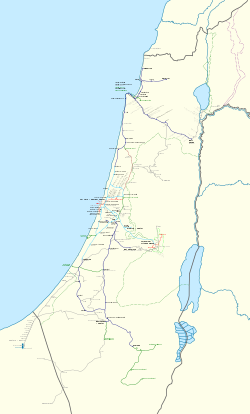| Israel | |||||
|---|---|---|---|---|---|
| Operation | |||||
| National railway | Israel Railways | ||||
| Infrastructure company | Israel Railways | ||||
| Major operators | Israel Railways | ||||
| Statistics | |||||
| Ridership | 69 million (heavy rail in 2019) | ||||
| Freight | 8.5 million tons (2019) | ||||
| System length | |||||
| Total | 1,511 km (939 mi) (heavy rail in 2022)[1] | ||||
| Electrified | 250 km (heavy rail in 2022) | ||||
| Track gauge | |||||
| Main | 1,435 mm | ||||
| Features | |||||
| No. stations | 69[2] | ||||
| Highest elevation | 750 m | ||||
| |||||
Rail transport in Israel includes heavy rail (inter-city, commuter, and freight rail) as well as light rail. Excluding light rail, the network consists of 1,511 kilometers (939 mi) of track, and is undergoing constant expansion. All of the lines are standard gauge and as of 2023[update] approximately one-fifth of the heavy rail network is electrified, with additional electrification work underway. A government owned rail company, Israel Railways, manages the entire heavy rail network. Most of the network is located on the densely populated coastal plain.
Some of the rail routes in Israel date back to before the establishment of the state – to the days of the British Mandate for Palestine and earlier. Rail infrastructure was considered less important than road infrastructure during the state's early years, and except for the construction of the coastal railway in the early 1950s, the network saw little investment until the late 1980s. In 1993, a rail connection was opened between the coastal railway from the north and southern lines (the railway to Jerusalem and railway to Beersheba) through Tel Aviv. Previously the only connection between northern railways and southern railways bypassed the Tel Aviv region – Israel's population and commercial center. The linking of the nationwide rail network through the heart of Tel Aviv was a major factor in facilitating further expansion in the overall network during the 1990s and 2000s and as a result of the heavy infrastructure investments passenger traffic rose significantly, from about 2.5 million per year in 1990 to about 67 million in 2018.
Israel is a member of the International Union of Railways and its UIC country code is 95.[3] Currently, the country does not have railway links to adjacent countries, but one such link is planned with Jordan. Further links existed with Egypt, Lebanon and Syria in earlier years. Unlike road vehicles and street trams, trains in Israel run on the left hand tracks.
In addition to heavy rail, several urban transport rail lines operate or are under construction in Israel. These include a short funicular underground railway in Haifa which opened in 1959 (Carmelit), a light rail line in Jerusalem (opened in 2011) and another light rail line in Tel Aviv, which began operations in 2023.
- ^ "Table 19.3 – Railway Services" (PDF). Statistical Abstract of Israel 74. Israel Central Bureau of Statistics. September 13, 2023. Retrieved November 26, 2023.
- ^ "Israel Railways opens Mazkeret Batya station". Globes. Daniel Schmil. 31 May 2019. Retrieved 7 July 2020.
- ^ "Archived copy". Archived from the original on 2011-10-07. Retrieved 2011-10-27.
{{cite web}}: CS1 maint: archived copy as title (link)
